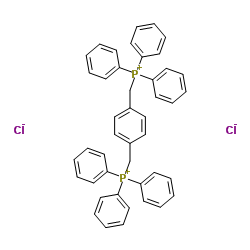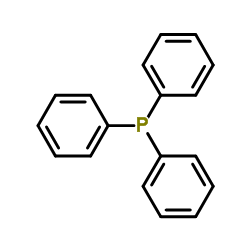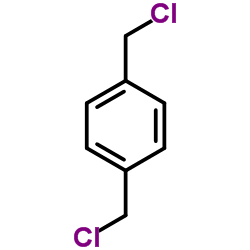1519-47-7
| Name | P-Xylylenebis(Triphenylphosphonium Chloride) |
|---|---|
| Synonyms |
[1,4-Phenylenebis(methylene)]bis(triphenylphosphonium) dichloride
EINECS 216-184-2 Phosphonium, 1,1'-[1,4-phenylenebis(methylene)]bis[1,1,1-triphenyl-, chloride (1:2) p-Xylylenebis(triphenylphosphonium chloride) (1,4-Phenylenebis(methylene))bis(triphenylphosphonium) chloride MFCD00031710 p-Xylylenebis(triphenylphosphoniumchloride) |
| Melting Point | >300ºC |
|---|---|
| Molecular Formula | C44H38Cl2P2 |
| Molecular Weight | 699.626 |
| Exact Mass | 698.182556 |
| PSA | 27.18000 |
| LogP | 2.68280 |
Synonym: Section 2 - COMPOSITION, INFORMATION ON INGREDIENTS
Risk Phrases: 20/21/22 36/37/38 Section 3 - HAZARDS IDENTIFICATION EMERGENCY OVERVIEW
Harmful by inhalation, in contact with skin and if swallowed. Irritating to eyes, respiratory system and skin.Hygroscopic (absorbs moisture from the air). Potential Health Effects Eye: Causes eye irritation. Skin: Causes skin irritation. Harmful if absorbed through the skin. Ingestion: Harmful if swallowed. May cause irritation of the digestive tract. Inhalation: Harmful if inhaled. Causes respiratory tract irritation. Chronic: Not available. Section 4 - FIRST AID MEASURES Eyes: Flush eyes with plenty of water for at least 15 minutes, occasionally lifting the upper and lower eyelids. Get medical aid. Skin: Get medical aid. Flush skin with plenty of water for at least 15 minutes while removing contaminated clothing and shoes. Ingestion: Get medical aid. Wash mouth out with water. Inhalation: Remove from exposure and move to fresh air immediately. If not breathing, give artificial respiration. If breathing is difficult, give oxygen. Get medical aid. Notes to Physician: Section 5 - FIRE FIGHTING MEASURES General Information: As in any fire, wear a self-contained breathing apparatus in pressure-demand, MSHA/NIOSH (approved or equivalent), and full protective gear. Extinguishing Media: Use water spray, dry chemical, carbon dioxide, or chemical foam. Section 6 - ACCIDENTAL RELEASE MEASURES General Information: Use proper personal protective equipment as indicated in Section 8. Spills/Leaks: Vacuum or sweep up material and place into a suitable disposal container. Avoid generating dusty conditions. Section 7 - HANDLING and STORAGE Handling: Avoid breathing dust, vapor, mist, or gas. Avoid contact with skin and eyes. Storage: Store in a cool, dry place. Store in a tightly closed container. Section 8 - EXPOSURE CONTROLS, PERSONAL PROTECTION Engineering Controls: Facilities storing or utilizing this material should be equipped with an eyewash facility and a safety shower. Use adequate ventilation to keep airborne concentrations low. Exposure Limits CAS# 1519-47-7: Personal Protective Equipment Eyes: Not available. Skin: Wear appropriate protective gloves to prevent skin exposure. Clothing: Wear appropriate protective clothing to prevent skin exposure. Respirators: Follow the OSHA respirator regulations found in 29 CFR 1910.134 or European Standard EN 149. Use a NIOSH/MSHA or European Standard EN 149 approved respirator if exposure limits are exceeded or if irritation or other symptoms are experienced. Section 9 - PHYSICAL AND CHEMICAL PROPERTIES Physical State: Solid Color: Not available. Odor: Not available. pH: Not available. Vapor Pressure: Not available. Viscosity: Not available. Boiling Point: Not available. Freezing/Melting Point: Not available. Autoignition Temperature: Not available. Flash Point: Not available. Explosion Limits, lower: Not available. Explosion Limits, upper: Not available. Decomposition Temperature: Solubility in water: Specific Gravity/Density: Molecular Formula: C44H38Cl2P2 Molecular Weight: 699.64 Section 10 - STABILITY AND REACTIVITY Chemical Stability: Stable under normal temperatures and pressures. Conditions to Avoid: Incompatible materials, exposure to moist air or water. Incompatibilities with Other Materials: Strong oxidizing agents. Hazardous Decomposition Products: Hydrogen chloride, carbon monoxide, oxides of phosphorus, carbon dioxide. Hazardous Polymerization: Has not been reported Section 11 - TOXICOLOGICAL INFORMATION RTECS#: CAS# 1519-47-7: TA3580000 LD50/LC50: Not available. Carcinogenicity: p-Xylylenebis(triphenylphosphoniumchloride) - Not listed by ACGIH, IARC, or NTP. Other: See actual entry in RTECS for complete information. Section 12 - ECOLOGICAL INFORMATION Other No information available. Section 13 - DISPOSAL CONSIDERATIONS Dispose of in a manner consistent with federal, state, and local regulations. Section 14 - TRANSPORT INFORMATION IATA Shipping Name: ORGANOPHOSPHORUS COMPOUND, SOLID, TOXIC, N.O.S.* Hazard Class: 6.1 UN Number: 3278 Packing Group: III IMO Shipping Name: ORGANOPHOSPHORUS COMPOUND, TOXIC, N.O.S. , SOLID Hazard Class: 6.1 UN Number: 3278 Packing Group: III RID/ADR Shipping Name: ORGANOPHOSPHORUS COMPOUND, TOXIC, N.O.S. Hazard Class: 6.1 UN Number: 3278 Packing group: III Section 15 - REGULATORY INFORMATION European/International Regulations European Labeling in Accordance with EC Directives Hazard Symbols: XN Risk Phrases: R 20/21/22 Harmful by inhalation, in contact with skin and if swallowed. R 36/37/38 Irritating to eyes, respiratory system and skin. Safety Phrases: S 26 In case of contact with eyes, rinse immediately with plenty of water and seek medical advice. S 36/37/39 Wear suitable protective clothing, gloves and eye/face protection. WGK (Water Danger/Protection) CAS# 1519-47-7: No information available. Canada CAS# 1519-47-7 is listed on Canada's NDSL List. CAS# 1519-47-7 is not listed on Canada's Ingredient Disclosure List. US FEDERAL TSCA CAS# 1519-47-7 is listed on the TSCA inventory. SECTION 16 - ADDITIONAL INFORMATION N/A |
CHEMICAL IDENTIFICATION
HEALTH HAZARD DATAACUTE TOXICITY DATA
|
| Hazard Codes | Xn:Harmful; |
|---|---|
| Risk Phrases | R20/22;R36/37/38 |
| Safety Phrases | S26-S36/37/39 |
| RIDADR | UN 3278 |
| RTECS | TA3580000 |
| Packaging Group | III |
| Hazard Class | 6.1 |
|
~97% 
1519-47-7 |
| Literature: Maerky, Michael Helvetica Chimica Acta, 1981 , vol. 64, # 4 p. 957 - 975 |



